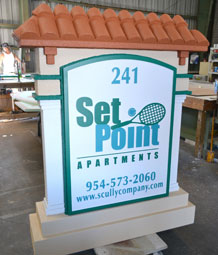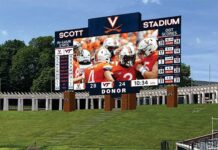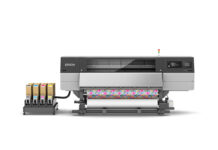Ubiquitous in towns and suburbs across the country, monument signage is as classic as signage gets. Its pervasive impression of heaviness, however, may be just that—a perception only.
Reminding us of the traditional methods that are used to manufacture and install this type of signage, Jim Nordquist, president of Viscom Architectural Graphics in Clearwater, Florida, points out that non-illuminated monument signs have typically been built on site on top of a poured concrete base.
“A mason would then create the monument structure using cinder block with stucco finish or brick construction,” he explains. “Once complete, a sign company would be called in to add the letters and graphic elements to complete the sign monument.”
Today it’s a walk in the park—at least when it comes to efficiency and material weight. It’s now possible to manufacture the entire structure, including the dimensional graphics, as a finished, lightweight product.
Proper Planning
Before launching a monument or any other exterior dimensional signage project, Nordquist points out some essential things to keep in mind.
First, he says, it’s imperative that the sign company employ due diligence for the client and check with the municipality signage regulations (including, of course, size) in their location.
“This is one of the biggest mistakes I see when my clients are designing these types of signs for their customers,” he says. “The last thing you want is to have your customer agree on your design and hand over the deposit to get the ball rolling, only to find out that the city will not allow you to install the structure that you spent so much time and effort on.
“Do your homework first and then start designing.”
Durability
Thanks to lighter weight materials like EPS foam, sign makers can not only mimic the look of traditionally constructed structures but also achieve a wider range of design options that would be near impossible or cost-prohibitive to accomplish using traditional construction methods.
In addition to eliminating the heavy weight, gone are the hassles of chipping stones and wearing foundations. Today there are materials that make monument signage long lasting and durable.
“We manufacture many of our monument structures using CNC hotwire-cut EPS foam, adding an extremely durable polyurethane hard coat, and then finish off with a mold-resistant acrylic stucco finish,” says Nordquist.
He recalls the first monument his shop constructed this way—a sign still keeps an eye on while driving to and from work since it was installed twenty years ago.
“Other than one paint job on the trim, the unit still looks amazing,” says Nordquist. “The durability of this type of construction is simply amazing, when done correctly.”
 Design
Design
Beyond durability, using EPS foam also allows Viscom’s clients to easily engage their customers in the design process and have it efficiently installed at their business.
Nordquist offers a few monument structure design tips:
- “Be creative, but don’t overdo it. Just because you can design almost any style and shape of monument doesn‘t mean you should.”
- “Take a look at your customer’s location (especially the style of the buildings) and implement some of the buildings’ design nuances to help complement and tie the two together.”
- “Take advantage of monument manufacturers’ Web sites and Google Images for inspiration. Today, there are hundreds of pictures of monuments to help you get an idea of what can and has been done.”
Recently Viscom has been fabricating monuments that incorporate nontraditional materials such as tile and decorative metals.
“This effect has great impact on the look of the sign, but we use only exterior-grade products in our design,” says Nordquist. “We’ve even reproduced barrel tile roofing using hard-coated foam to match existing construction. We then maybe add a real brick or stone base.
“This not only looks great but adds extra protection against weed wackers and lawnmowers.”
Viscom still occasionally does turn to the tried-and-true methods of manufacturing monument signage by working with heavier materials like real stone, as well as working with welded aluminum construction for larger structures.
“Real stonework adds protection and curb appeal, but it also a few pounds to the finished product, which should be taken into consideration when there are limited installation resources,” says Nordquist.
A final, but critical design element, are the dimensional letters and logos that make the signage “sing.”
“When you’ve designed a great-looking structure that, by its very nature, has many dimensional elements, adding a flat, digitally printed face to it just won’t do justice compared to a nice sandblasted or routed face or dimensional letters and graphics,” says Nordquist. “It’s all about dimension.”
Between those two options, Viscom does about 60 percent dimensional letters and 40 percent sandblasted or routed faces.
“Instead of using flat cut-outs for everything, some of our clients will add sculpted and hard-coated EPS graphics that allows the imagery to stand out,” says Nordquist.
As Viscom has been part of monument signage’s rise through modern history, the company has worked on designs from the simplest to the most complex.
“Some of the more elaborate designs we’ve seen include monuments with built-in planters, others that incorporate water features with recycling water systems, and signs with built-in mailboxes,” says Nordquist.
One sign, in particular, included full columns built using translucent acrylic with internal RGB LED lighting controlled via remote control.
“The sky’s the limit, especially if a monument can be considered lightweight,” he says.
Installation
When it comes to working with lighter monument signage, one of the greatest perks is the ease of installation. Once the EPS foam monument sign is delivered to the site, two to four people can handle the job in under two hours.
“First installers will set the mounting pipes into the monument, then dig two or three holes in the ground,” explains Nordquist. “They set the monument with pipes into those holes, typically holding the sign off the ground a few inches with wood blocks. They then mix and pour the concrete into the holes.
“Finally, they pull out the wood blocks and push the structure toward the ground.”
At this stage, it’s important that everything is level before the concrete sets.
By Lori Shridhare
All photos: Viscom Architectural Graphics











